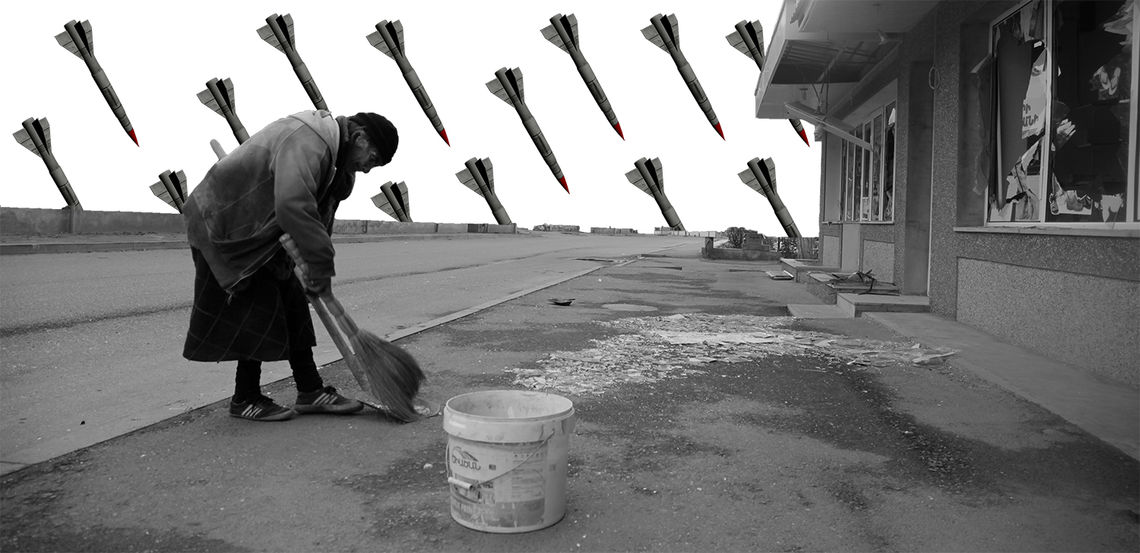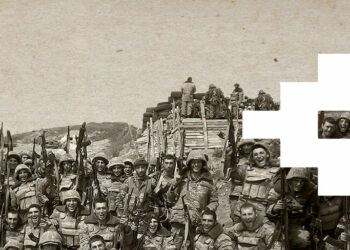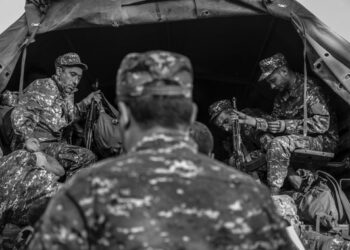

The present essay explains the origins of the doctrine of Responsibility to Protect, followed by a discussion of remedial secession — all to answer the simple question whether the armed conflict of international character waged by Azerbaijan and Turkey against Armenia and Nagorno-Karabakh warrant an international recognition of Artsakh’s remedial secession.
Short answer: It depends.
Let me explain in a few steps.
The Emergence of Responsibility to Protect (R2P)
The political concept of the Responsibility to Protect, or R2P, is a post-Kosovo development in international politics and law that was meant to replace the more negative doctrine of humanitarian intervention with a novel term and shift the debate from armed intervention to international cooperation for atrocity prevention. The NATO bombing of Yugoslavia in 1999 and the subsequent assessment thereof by the Kosovo Commission as “illegal but legitimate” highlighted the need to find a more balanced and consensual approach to addressing, in the words of UN Secretary-General and 2001 Nobel Peace Prize laureate Kofi Annan, “gross and systematic violations of human rights that offend every precept of our common humanity” by trespassing the norm of state sovereignty. The new approach was meant to pacify the states, mainly those in the Non-Aligned Movement, that interpreted “humanitarian intervention” as a new form of neo-colonialism. The new term was coined by the UN High-Level panel, co-chaired by Gareth Evans and Mohamed Sahnoun, called International Commission on Intervention and State Sovereignty, which released its report in December 2001. Subsequently, there had been more High-Level groups under the offices of the UN Secretary-General until 2005, when the concept was formally accepted by all Heads of States in the World Summit Outcome Document [the Armenian perspective here], and then in 2006 by the UN Security Council (UNSC) in Resolution 1674 – cited in many relevant R2P resolutions afterwards.
The subsequent development of the R2P boiled down this concept to three pillars:
1- The protection responsibilities of the State;
2- international assistance and capacity-building; and, in cases of failure of the first two,
3- timely and decisive response to humanitarian catastrophes by the international community – sanctioned by UN Security Council resolutions.
The latter part was enshrined in the 2005 UN Document paragraphs 138-139 to pacify Third World countries and provide additional guarantees against unilateral use of force under the veil of new and legitimate doctrine. The second and third pillars, outlined in detail in the first relevant report by the UN Secretary-General in 2009, included not only formal cooperation of states to build disaster-response capacity but also, when necessary, Chapter VI (consent-based) peacekeeping or Chapter VII peace enforcement (Libya 2011, Mali 2013, etc.) operations. Two key differences between the UN-approved norm and the 2001 Commission report recommendations were in underlining the primacy of the UN Security Council and the rejection of any generic list of criteria to warrant such foreign interference. Nevertheless, the Third Pillar situations would involve such that, on the level of individual criminal responsibility, are dealt with by the International Criminal Court under Article 5: genocide, crimes against humanity, war crimes and crime of aggression (latter in force since December 2017) – leaving the chief political issue about the R2P to be the “gravity” of the alleged crime and the role of the sitting government in it.
In later years, the international community departed from the political concept of R2P, mainly due to frequent abuses by great powers. The last two straws in this had been the application of this language and action in Libya (blessed by UNSC Resolutions 1970 and 1973) and the hesitation to do so in Syria [I attempted to respond to the question of “…why not Syria, but Libya” back in 2015].
What Is “Remedial Secession?”
The legal term of “remedial secession,” embodied in international law, describes situations where an identifiable, unified and cohesive group of people may have the legal and political right to secede from a parent State as a measure of protection against widespread, systematic and gross violations of internationally recognised human rights, such as ethnic cleansing, crimes against humanity or genocide, or an imminent threat thereof. Not to dive into deep legal debate, this is embodied in the Declaration on Principles of International Law concerning Friendly Relations and Cooperation among States, adopted by the UN General Assembly in 1970.
Where Did Armenia Stand Before September 27, 2020?
In the early 1990s, Armenian diplomacy made a few attempts to voice the humanitarian aspects of the conflict and make it part of the official government position, including in official communications with the members of the UN Security Council in 1992-94. Partly successful, those aspects were reflected both in four 1993 UNSC Resolutions [read more about how these resolutions were not anti-Armenian] and in the CSCE/OSCE Budapest Summit Document of 1994, which called upon “…the participating States to take action, both individually [emphasis added] and within relevant international organizations, to provide humanitarian assistance to the people of the [Nagorno Karabakh] region…”
Armenia has had solid grounds to invoke the language of “remedial secession” both in 1991 – with reference to the Sumgayit, Kirovabad and Baku pogroms against Armenians (which was raised numerous times in the Armenian Government letters to the UNSC members in 1993), as well as after the 1992-94 war with reference to war crimes perpetrated by independent Azerbaijan (Maragha 1992, etc.). To strengthen this argumentation, the Information and Public Relations Center under the Office to the President produced in 2011-14 a series of documentaries, titled “Ordinary Genocide” and books – in a number of foreign languages – to raise awareness among the public, both in Armenia and abroad. The Armenian diplomatic corps used the produced materials at public events worldwide. This content was uploaded to specialized websites and YouTube.
In realpolitik terms, the international community, and chiefly the European Union and United States, for whom the concept of human rights in armed conflicts was believed to have higher value, continued looking at the case of Nagorno Karabakh through a post-Soviet prism.
The 2016 Four Day April War, notwithstanding the new set of war crimes on the battlefield and against the civilian population by Azerbaijani troops, has not created any new momentum in international politics either. The cases, submitted to the European Court of Human Rights by prominent lawyers in cooperation with the Government Ombudsmen of Armenia and Artsakh in the aftermath of the April war, have yet to be deliberated in Strasbourg.
Further, in 2017, the Armenian government funded research to produce a white paper by prominent legal scholars and practitioners (some of whom currently occupy key public positions) on the subject of remedial secession. It must be hoped that the sealed white paper and other open source research of the past years will be fully utilized in the strategizing of Armenian foreign and security policy in the coming months, following the ceasefire negotiated in Moscow on October 10, 2020.
To conclude, this debate is not new in Armenian politics. The chief advocate for the R2P doctrine and what he called “remedial sovereignty” pertaining to Nagorno-Karabakh was my late friend and teacher Ambassador Rouben Shougarian. He discussed the topic at many public lectures and speeches since 2008, and as recently as our AUA conference in November 2019. Coincidentally, just three days prior to the recent all-out war in Artsakh, Armenian Foreign Affairs Minister Zohrab Mnatsakanian, who has been a keen advocate of R2P in his prior positions, participated remotely at the 12th Ministerial Meeting on the Responsibility to Protect.
What Is the New Situation After September 27, 2020?
This latest stage of reinvigorated debate on whether the narrative of “remedial secession” must be incorporated in the conflict resolution process was stirred (like in May 2016) by former President Levon Ter-Petrosyan, with reference to the Geneva Municipal Council resolution of October 7, 2020, which acknowledged self-determination “as the only way to ensure their safety [in Nagorno Karabakh].” A statement reminiscent of this narrative was delivered by Armenia’s representative to the UNHCR Executive Committee. On October 9, UN High Commissioner for Human Rights Michelle Bachelet made a statement on the human costs of the ongoing war, with emphasis on the territory of Nagorno-Karabakh.
To many in Armenia, it seems that Nagorno-Karabakh has already employed its right to “remedial secession” and even defended it in three wars, yet the debate I bring forward pertains to the international recognition aspects of this self-determination, which is different than unilateral declarations.
To draw preliminary conclusions about whether there is any new space to employ R2P and “remedial secession” language, we have to address four sets of factors, which need to be expanded further in the future as Azerbaijan’s unprovoked military aggression is well-established:
1- Scale of civilian casualties and destruction of infrastructure,
2- War crimes and/or intent to commit such crimes,
3- Interim status and peacekeeping operation,
4- Recognition.
First, has there been any significant destruction and indiscriminate fire on civilian infrastructure and non-combatant casualties in Nagorno-Karabakh that can be independently verified by international institutions? There is no doubt that the authorities in Nagorno-Karabakh have already gathered enough evidence of this. Hence, the answer seems to be yes.
Second, did Azerbaijani troops, with or without direct command, commit war crimes during the armed hostilities? It seems the intent of the Azerbijani leadership can be established with relative ease. In a nutshell, it was this intent of Colonel Muammar Gaddafi that warranted two resolutions in 2011 and intervention in Libya (the poor execution of which led to the current hesitation regarding R2P in international politics). Ilham Aliyev is a war criminal and it seems there is little doubt about this in the international community, while Turkish leadership has aided and abetted the commission of his crimes, to quote Article 16 of the Draft Articles of State Responsibility (2011). Aliyev’s and Azerbaijan’s role in international energy security is artificially inflated, primarily by the media, experts on their payroll and politicians – and that shall not be too hard to credibly establish with a calculator in hand.
The International Criminal Court (to which neither Armenia nor Azerbaijan are members yet) was finally given jurisdiction in 2017 to review cases about the crime of aggression. After the battlefield is cleared, most probably other war crimes will also be well documented (such as the double targeting of the Shushi Cathedral by rocket fire), including the issue of treatment of POWs.
Third, in other ethnic conflicts, and Kosovo is one example, remedial secession and later declaration of independence were preceded by the establishment of the United Nations Interim Administration Mission in Kosovo (UNMIK), pursuant to Security Council Resolution 1244 (1999). It’s unknown at this stage whether the Basic Principles, dated November 2007, or any of its later iterations, that contained provisions of interim status and multinational peacekeeping operation, are going to remain on the table. The ceasefire arrangement, released in the form of a press statement by the Foreign Affairs Ministers of Russia, Armenia and Azerbaijan on October 10, doesn’t provide clarity on this either (and it did not have to).
One argument can be that, in contrast to other conflicts, including Kosovo, Nagorno-Karabakh Republic has resilient state institutions, a democratic form of government and laws, holds regular elections, etc. – and thus any interim status will be a downshift, let alone alien to the local realities.
Whether any robust peacekeeping operation will be dispatched at this point in time also remains unknown. It’s only clear that the past behavior of Ilham Aliyev’s regime does not give high hopes for any respect to the pacta sunt servanda principle and that ceasefire violations, if not another war, are imminent. Given the geopolitics of the region, it is a good guess that consent-based peacekeeping forces at some stage are going to be dispatched. The source of their legitimacy (UNSC, OSCE, ad hoc coalition or unilateral arrangement), as well as their mandate, must consider the long list of past failures of both the UN and OSCE (most notably in Ukraine). To speculate further, such an arrangement can also be based on the high-level Vienna agreements in the aftermath of the 2016 April War – pertaining to expanding the monitoring mission by the OSCE (thus a ceasefire verification mission and not peacekeepers on the ground), which given the scale of the current war has to be made more robust.
Fourth and finally, Armenian Prime Minister Nikol Pashinyan has called upon the international community, and particularly France in the latest interviews with Euronews and others, to recognize the Republic of Artsakh as a measure to prevent a humanitarian catastrophe. It must be flagged that the recognition of states is an inherently political, not a legal, act.
This discussion does not mean that the political concept of remedial secession will be applied to Nagorno-Karabakh automatically, or that the barbarism of the Azerbaijani political-military leadership creates momentum for international recognition. This shall be a concerted effort by the Foreign Ministry, parliamentary diplomacy and on the track-two level to raise awareness, polish the official position, make new allies and re-energize old ones, with the creative use of all the “tools in the toolkit.” A lot of work ahead, for everyone on all levels.
also read
Azerbaijan, Turkey Responsible for Grave Breaches of Humanitarian Law
Azerbaijan, in collaboration with Turkey is responsible for grave breaches of international humanitarian law and war crimes. The international tribunal should not turn a blind eye to the situation.
Read moreThe Real Perpetrator of the 2020 Artsakh War
Statements and hints by Azerbaijan about an impending war went unheeded. Why would Armenia want to halt the negotiation process to start a war? Here are some of the facts and context which demonstrate it was Azerbaijan that started the war.
Read moreFighting for Existence: Armenia Battles Two Repressive Regimes and Mercenaries
Given the geography, tactics and methods of the Azerbaijani offensive, the autocratic regime of Ilham Aliyev is aiming to forcibly occupy the territory of Artsakh through committing large-scale atrocities.
Read moreTurkish, Western Self-interest Behind Artsakh Bloodshed
As the hordes mass at Armenia’s gates, the U.S. and Europe, the supposed guardians of peace and justice, remain reluctant to intervene to halt the violence due to self-interest and capitulation to Turkish blackmail.
Read morephoto stories
Martakert: A City Fractured
The city of Martakert in Artsakh came under heavy shelling twice since the start of the war. This photo story captures the aftermath.
Read moreA Home to War
These powerful images capture fragments of life in Artsakh, a place that is boundlessly resilient yet has too often become a home to war.
Read more






